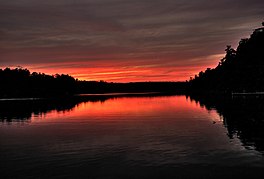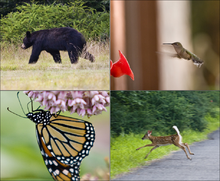
Sullivan County is a county in the Commonwealth of Pennsylvania. It is part of Northeastern Pennsylvania. As of the 2020 census, the population was 5,840, making it the second-least populous county in Pennsylvania. Its county seat is Laporte. The county was created on March 15, 1847, from part of Lycoming County and named for Major General John Sullivan.

Fairmount Township is a township in Luzerne County, Pennsylvania, United States. The population was 1,207 at the 2020 census. Fairmount Township is home to Ricketts Glen State Park. The park receives tens of thousands of visitors each year.

Ricketts Glen State Park is a Pennsylvania state park on 13,193 acres (5,280 ha) in Columbia, Luzerne, and Sullivan counties in Pennsylvania in the United States. Ricketts Glen is a National Natural Landmark known for its old-growth forest and 24 named waterfalls along Kitchen Creek, which flows down the Allegheny Front escarpment from the Allegheny Plateau to the Ridge-and-Valley Appalachians. The park is near the borough of Benton on Pennsylvania Route 118 and Pennsylvania Route 487, and is in five townships: Sugarloaf in Columbia County, Fairmount and Ross in Luzerne County, and Colley and Davidson in Sullivan County.

Worlds End State Park is a 780-acre (316 ha) Pennsylvania state park in Sullivan County, Pennsylvania. The park, nearly surrounded by Loyalsock State Forest, is in the Loyalsock Creek valley on Pennsylvania Route 154 in Forks and Shrewsbury Townships southeast of the borough of Forksville. The name Worlds End has been used since at least 1872, but its origins are uncertain. Although it was founded as Worlds End State Forest Park by Governor Gifford Pinchot in 1932, the park was officially known as Whirls End State Forest Park from 1936 to 1943.

Bowman Creek is a tributary of the Susquehanna River in Luzerne County and Wyoming County, in Pennsylvania, in the United States. It is approximately 26 miles (42 km) long and flows through Ross Township and Lake Township in Luzerne County and Noxen Township, Monroe Township, and Eaton Township in Wyoming County. The watershed of the creek has an area of 120 square miles (310 km2). The creek is not designated as an impaired waterbody and its pH is close to neutral, although it has experienced some problems with acid rain. It has low concentrations of dissolved solids like calcium. The creek is relatively small in its upper reaches, but by Noxen, its width is 40 to 60 feet. It is also relatively shallow in many reaches. Rock formations in the watershed include the Catskill Formation, the Huntley Mountain Formation, Burgoon Sandstone, the Mauch Chunk Formation, the Pottsville Group, and the Pocono Formation. Soil associations in the creek's watershed include the Wellsboro-Morris-Oquaga association, the Oquaga-Lackawanna-Arnot association, the Mardin-Bath-Volusia association, and the Wyoming-Pope association.

The Geology of Pennsylvania consists of six distinct physiographic provinces, three of which are subdivided into different sections. Each province has its own economic advantages and geologic hazards and plays an important role in shaping everyday life in the state. They are: the Atlantic Coastal Plain Province, the Piedmont Province, the New England Province, the Ridge and Valley Province, the Appalachian Plateau Province, and the Central Lowlands Province.

There are 24 named waterfalls in Ricketts Glen State Park in the U.S. state of Pennsylvania along Kitchen Creek as it flows in three steep, narrow valleys, or glens. They range in height from 9 feet (2.7 m) to the 94-foot (29 m) Ganoga Falls. Ricketts Glen State Park is named for R. Bruce Ricketts, a colonel in the American Civil War who owned over 80,000 acres in the area in the late 19th and early 20th centuries, but spared the old-growth forests in the glens from clearcutting. The park, which opened in 1944, is administered by the Bureau of State Parks of the Pennsylvania Department of Conservation and Natural Resources (DCNR). Nearly all of the waterfalls are visible from the Falls Trail, which Ricketts had built from 1889 to 1893 and which the state park rebuilt in the 1940s and late 1990s. The Falls Trail has been called "the most magnificent hike in the state" and one of "the top hikes in the East".

Kitchen Creek is a tributary of Huntington Creek in Luzerne County, Pennsylvania, in the United States. It is approximately 10.6 miles (17.1 km) long and flows through Fairmount Township and Huntington Township. The watershed of the creek has an area of 20.10 square miles (52.1 km2). The creek is designated as a high-quality coldwater fishery.

The Clemuel Ricketts Mansion is a Georgian-style house made of sandstone, built in 1852 or 1855 on the shore of Ganoga Lake in Colley Township, Sullivan County, Pennsylvania in the United States. It was home to several generations of the Ricketts family, including R. Bruce Ricketts and William Reynolds Ricketts. Originally built as a hunting lodge, it was also a tavern and post office, and served as part of a hotel for much of the 19th century.
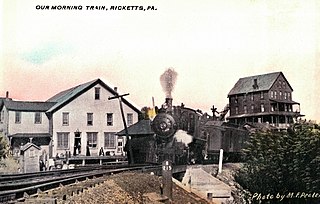
Ricketts is a ghost town that was established as a lumber mill company town in Sullivan and Wyoming counties, in the U.S. state of Pennsylvania. Ricketts was built in 1890 along Mehoopany Creek in both Colley Township in Sullivan County and Forkston Township in Wyoming County for sawmills of the Trexler and Turrell Lumber Company. It was named for Robert Bruce Ricketts, who owned most of the land and timber around the village, and who was a partner in the company with Harry Clay Trexler, J.H. Turrell, and others. Ricketts had 800 inhabitants at its peak and extended into the northernmost section of what is now Ricketts Glen State Park. Rail lines were built to the mills at Ricketts, including the Bowman Creek branch of the Lehigh Valley Railroad which opened in 1893. The mills closed in 1913 when the lumber was exhausted and the last house was torn down in the 1930s.

North Mountain is a 2,584-foot (788 m) ridge primarily located in Davidson Township of Sullivan County in the U.S. state of Pennsylvania. Its summit is that county's highest point, the 10th highest among the state's 67 counties. Portions also extend into neighboring Lycoming, Luzerne, and Wyoming counties. The mountain has a topographic isolation of 57.99 miles (93.33 km). U.S. Route 220 passes near the mountain. The mountain once had a prolific population of animals, including grouse, deer, and bears.

Crooked Creek is a tributary of Kitchen Creek in Luzerne County, Pennsylvania, in the United States. It is approximately 1.8 miles (2.9 km) long and flows through Fairmount Township. The watershed of the creek has an area of 1.20 square miles (3.1 km2) and there is one named tributary. The creek is considered to be Class A Wild Trout Waters and a portion of it flows through Ricketts Glen State Park. Wisconsinan Till, Wisconsinan Outwash, and alluvium can be found in its vicinity.

Pennsylvania State Game Lands Number 13 are Pennsylvania State Game Lands in Columbia County and Sullivan County, in Pennsylvania, in the United States. They have an area of 49,529 acres. The game lands are mountainous and contain streams such as West Branch Fishing Creek and its tributaries. The main game animals in the area include bear, deer, grouse, turkey, and waterfowl. The game lands are adjacent to Pennsylvania State Game Lands Number 57.
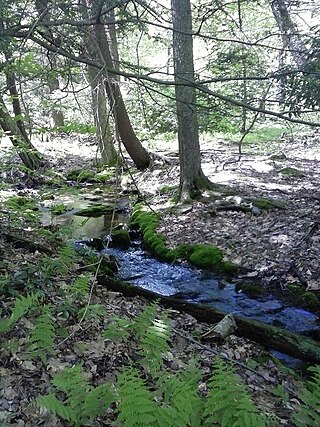
Maple Spring Brook is a tributary of Kitchen Creek in Luzerne County, Pennsylvania, in the United States. It is approximately 0.6 miles (0.97 km) long and flows through Fairmount Township. The watershed of the stream has an area of 0.40 square miles (1.0 km2). There is a waterfall in the stream's upper reaches and hemlock trees occur in the vicinity. The surficial geology in the area consists mainly of Wisconsinan Till, Wisconsinan Bouldery Till, wetlands, and bedrock consisting of shale and sandstone.
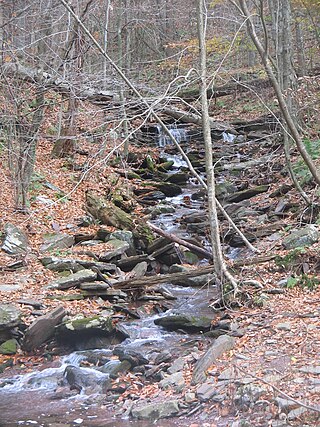
Shingle Cabin Brook is a tributary of Kitchen Creek in Luzerne County, Pennsylvania, in the United States. It is approximately 0.9 miles (1.4 km) long and flows through Fairmount Township. The watershed of the stream has an area of 0.47 square miles (1.2 km2). It is in Ricketts Glen State Park. The stream has one waterfall, which is known as Shingle Cabin Falls. The surficial geology in the area features Wisconsinan Till, Wisconsinan Bouldery Till, and bedrock consisting of sandstone and shale.

Lake Jean is a lake in Luzerne County and Sullivan County, in Pennsylvania, in the United States. It has a surface area of approximately 245 acres (99 ha) and is situated in Colley Township, Sullivan County and Fairmount Township, Luzerne County. The lake's main inflow is the outlet of Ganoga Lake. Lake Jean is fairly shallow, with an average depth of 5.9 feet (1.8 m). It is in the watershed of Fishing Creek. The main rock formations in the lake's watershed include Burgoon Sandstone and the Mauch Chunk Formation. The lake is dammed by the Lake Jean Dam and is owned by the Pennsylvania Department of Conservation and Natural Resources.

Lake Rose is a dry lake in Luzerne County, Pennsylvania, in the United States. It has a surface area of approximately 25 acres (10 ha), and is situated in Fairmount Township. Lake Rose is mostly dry and closely resembles a swamp. Its main inflow is the spillway from Lake Jean. Lake Rose was originally constructed by a squatter named Jesse Dodson. Wildlife, including birds, butterflies, and dragonflies, has been observed near the lake. A number of hiking trails are also in its vicinity.
North Branch Bowman Creek is a tributary of Bowman Creek in Luzerne County, Pennsylvania, in the United States. It is approximately 3.2 miles (5.1 km) long and flows through Fairmount Township and Ross Township. The watershed of the creek has an area of 2.63 square miles (6.8 km2). The creek is not designated as an impaired waterbody. The surficial geology in its vicinity includes Wisconsinan Till, alluvial fan, Boulder Colluvium, alluvium, bedrock, and a peat bog. The creek is mostly in Pennsylvania State Game Lands and Ricketts Glen State Park.
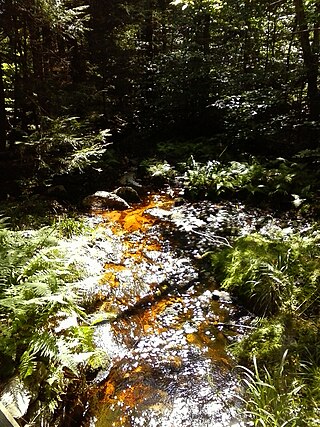
South Branch Bowman Creek is a tributary of Bowman Creek in Luzerne County, Pennsylvania, in the United States. It is approximately 3.0 miles (4.8 km) long and flows through Fairmount Township and Ross Township. The watershed of the creek has an area of 3.92 square miles (10.2 km2). The surficial geology in its vicinity consists of alluvial fan, alluvium, Wisconsinan Ice-Contact Sratified Drift, fill, lakes, Boulder Colluvium, Wisconsinan Till, Wisconsinan Bouldery Till, wetlands, and bedrock. Most of the creek is in Ricketts Glen State Park. It has one named tributary, which is known as Cherry Run. The creek's watershed is designated as a High-Quality Coldwater Fishery and a Migratory Fishery.
